Introduction and Purpose
Seed saving is the art and practice of preserving and sharing seeds from desired open-pollinated plants. Saving seeds has many benefits and motivations that may include improving the adaptability of a crop to a region or microclimate, preserving cultural traditions and foods, growing for nutrient density and flavor preferences, saving on the cost of seed purchases, and connecting to local communities through seed sharing. For example, you may start saving seeds to preserve a beloved heirloom variety with flavors that remind you of home or to improve on a crop that performed particularly well. Saving your own seeds can save money, as one good growing season can produce many years’ worth of seeds. This publication is for farmers and gardeners interested in producing, using, or donating seeds from open-pollinated plants. It recommends practices to produce, harvest, and store seeds from annual vegetable, fruit, and herb crops. This guidance is not intended for commercial purposes.
The seed development process depends on good plant care.
The production of high-quality seeds begins with the seed developmental process that takes place on mother plants. Seed development starts from the flowering stage and progresses into a series of steps including pollination, sexual reproduction involving the fusion of male pollen and female egg cells (i.e., fertilization), and early embryo and seed development. This process culminates in fully matured seeds. Each step requires continued crop maintenance. Particular attention should be given to providing consistent soil moisture through irrigation or sufficient rainfall, fertilizer application when necessary for improved plant health, weeding, and pest or pathogen control. These practices facilitate the development of high-quality seeds.
The endosperm surrounds the embryo and consists of nutrient material that will sustain seedling growth after germination. The embryo and endosperm start to form after fertilization takes place in the flower. The embryo formation phase includes a series of biological and chemical events leading to seed development. Subsequently, immature seeds begin to fully mature. Towards the end of seed development, the seed drying phase occurs, so water requirements are not as strict as they were at the beginning of the process. Mature seeds are naturally equipped with the resources necessary to be stored and to germinate, but proper post-harvest handling and storage are necessary for longer-term seed viability maintenance.
Will my crops produce seeds in North Florida?
We are lucky to have a state filled with successful farmers and gardeners who grow delicious crops. Despite the wide range of crops grown for consumption, continuing to care for these crops through seed maturity is challenging in our warm and humid climate. Some crops only produce seeds when specific biological and climate requirements are met. Even if you can easily grow an edible crop, that same crop may not be successful at producing seeds that reach maturity. For example, many biennial plants, including brassicas such as cabbage, Brussels sprouts, kale, collards, and root crops like carrots, beets, and onions, must experience cold temperatures at or below a specific threshold (e.g. 30°F–60°F, 0°C–16°C) for a particular length of time (2–10 weeks) to produce seeds the following spring and are particularly challenging to grow for seeds in southern climates. Exceptions include the selection of specific varieties that require a shorter period of cold temperatures, growing in microclimates where enough cold day requirements are met, or unusually cold winters that trigger the steps needed for a plant to produce flowers and mature seeds. Table 1 summarizes common garden crops likely to produce viable seeds in north Florida.
Do I have space and time to produce seeds?
Some crops require many plants flowering simultaneously to produce high-quality and viable seeds. If you are growing too few plants, the quality of seeds could decline over time due to genetic inbreeding, which is the mating of closely related plants in small populations. On the contrary, some self-pollinating crops, like peas, beans, lettuce, and tomatoes, plants that can fertilize themselves, in other words, have little to no chance of crossing with others of their species and do not require more than one plant to save seeds. However, saving seeds from as many plants as possible is always recommended to increase genetic diversity and seed quality. Some crops allowed to grow fully to seed production may take more room in the garden as they continue growing and become heavy with seed-bearing pods and fruits. Some, like kale or mustard, may require staking to keep the heavy and wide flowering stalks and seed pods upright (Figure 1). Table 1 provides recommendations for how many flowering plants are necessary to save viable, high-quality seeds.
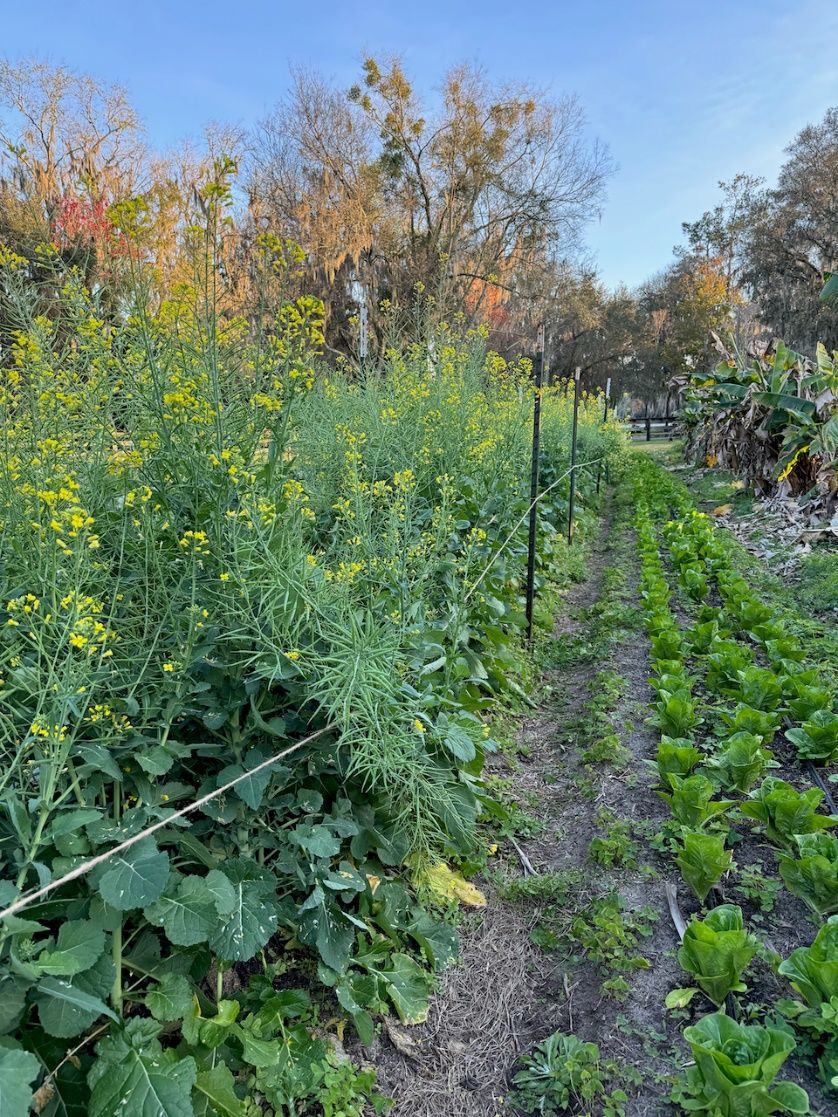
Credit: Melissa DeSa, Working Food
What is pollination?
Pollination is the movement of pollen from male to female parts of a flower. Pollen grains move from a flower’s anthers (male or pollen-giving parts) to the stigma (female or pollen-receiving parts). The strategies, or breeding methods, to achieve this are complex and variable depending on the plant, pollinator populations, and local climates.
Self-pollinating plants have both pollen-giving and pollen-receiving organs within the same flower and do not require insects or wind to move pollen. However, a slight vibration from wind or an insect landing on the flower can facilitate the process and improve pollination. Table 1 lists the pollination methods of crops that can produce seeds in north Florida.
Tomatoes, beans, lettuce, and peas are typically self-pollinating but occasionally can be cross-pollinated, depending on local factors such as variety, climate, and pollinator populations (Figures 2 and 3).
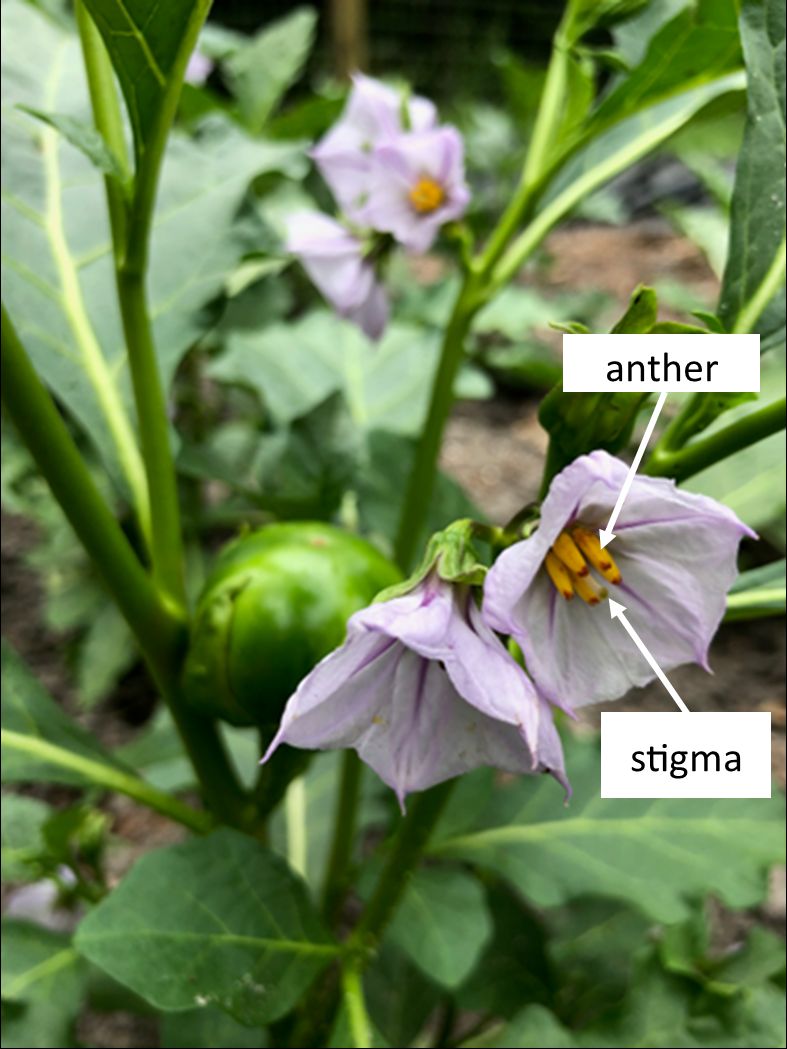
Credit: Melissa DeSa, Working Food
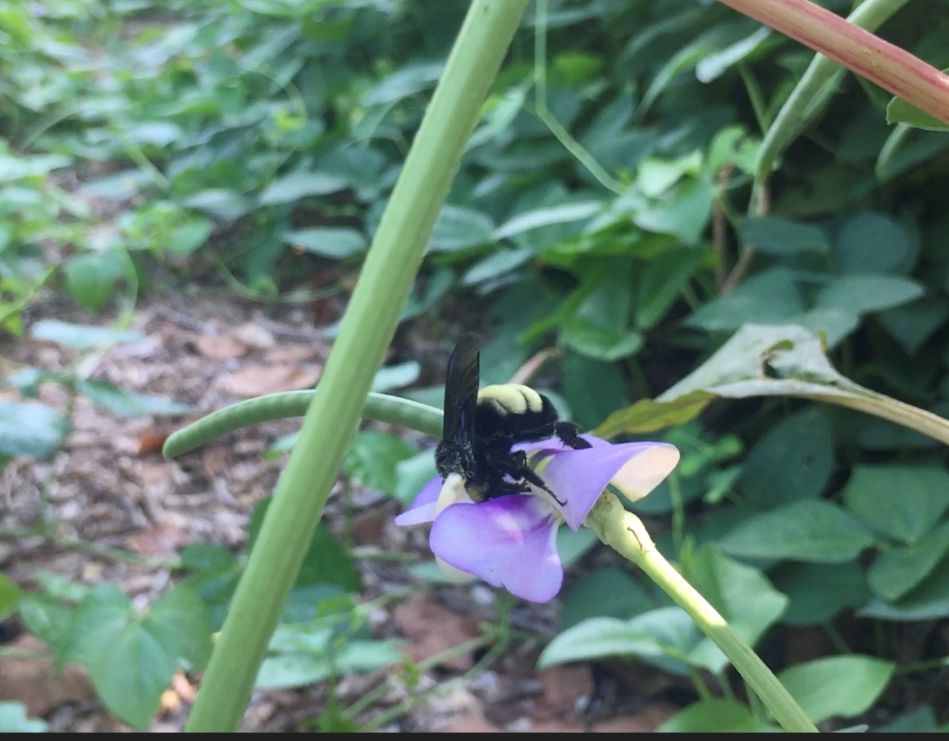
Credit: Melissa DeSa, Working Food
Cucurbits (e.g., squash, cucumber, melons) have unisexual flowers, meaning the pollen-giving and pollen-receiving parts are within separate flowers that occur on the same plant. They require insects to move the pollen from one flower to another (Figures 4 and 5).
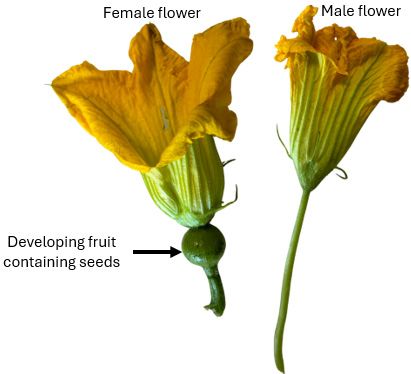
Credit: Melissa DeSa, Working Food
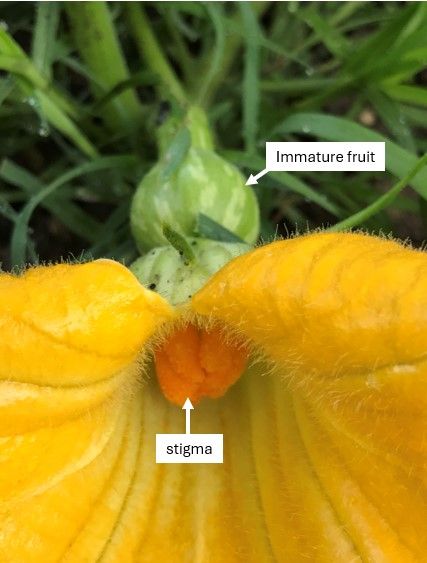
Credit: Tere Davidson, formerly of UF/IFAS
Okra, peppers, and eggplants all have flowers with pollen-giving and pollen-receiving reproductive parts (Figure 2) but are capable of both self- and cross-pollination. This means that pollen moves via insects from one flower to another on the same plant or on a different plant. Brassicas (e.g., kale, collards, arugula, mustards) also have flowers with pollen-giving and pollen-receiving reproductive parts but are not capable of self-pollinating and require insects to carry pollen from one plant to another.
Can I save seeds from hybrid and open-pollinated plants?
Plant hybridization, or the intentional movement of pollen between plants to create improved offspring, has been important to humans since the beginning of agriculture. Modern agricultural plant hybrids result from intensive breeding programs often under highly controlled conditions. Commercial hybrid seeds are produced from parent plants of the same species but display distinct characteristics that are passed on to the hybrid offspring. Hybrids are expected to be more vigorous than any parent variety and are typically very uniform. Pollination is highly controlled in the production of hybrid seeds and is done in specialized growing operations.
If seeds are hybrid, it will say so on the seed packet or website. It is not common practice to save seeds from commercially available first-generation (F1) hybrids, as their seeds will not produce plants that are true to type. In other words, the resulting offspring will be unpredictable. For example, if you save seeds from the F1 hybrid Sungold tomato, the tomatoes you grow next season with those saved seeds will be very different from their Sungold parents.
Some hybrid varieties are patented; therefore, ownership is limited to a public or private organization. Seeds may be available to commercial farmers who pay a fee for the right to purchase the seeds and grow the crop’s edible portion for harvest. However, they are not allowed to save the seeds for future production. When in doubt, it is best to determine if there are any legal restrictions to saving hybrid patented seeds before you get started.
Open-pollinated seeds are formed when pollen is carried by insects, birds, or wind to a female flower. An open-pollinated variety will produce seeds that develop plants nearly identical to their parents if they are not allowed to cross-pollinate with others of the same species.
Saved seeds from an open-pollinated variety like Everglades currant tomato will grow true-to-type as Everglades tomatoes next season, as long as precautions were taken to prevent them from cross-pollinating with other tomato varieties. This is because pollen from other tomato varieties will introduce traits different from the desired traits due to cross-pollination. Such cross-pollination can lead to more variability, thereby decreasing the appearance of a desired trait in resulting plants. Open-pollinated crops are predictable when care is taken to minimize cross-pollination with other varieties; you know what to expect when growing them.
How do I minimize cross-pollination?
To save seeds from a crop that cross-pollinates easily, you must plant that crop in isolation from other varieties of the same species to prevent unwanted cross-pollination. Planting in isolation means maintaining crops of similar species or varieties at a sufficient distance from one another to avoid cross-pollination (Table 1). Isolation can also include planting similar varieties near each other but at a time when the different varieties will not be flowering simultaneously. Preventing cross-pollination via isolation will ensure the seeds that develop in your crop will be like their parents. Knowing the scientific name is essential because common names are not a reliable indicator of a crop’s genetics. Use the scientific name of the species, in addition to the variety or cultivar name, to determine what others are genetically compatible and thus capable of producing seeds with characteristics from both varieties. Table 1 lists species names and isolation distances. The distances are suggestions, but each unique growing location will factor into what distances and other isolation measures might impact cross-pollination. For example, the presence of buildings and other attractive flowers in between crops and the existing health of local pollinator populations will impact the rates and likelihood of cross-pollination.
Cucurbita moschata is an example of a species with different varieties that often cross-pollinate. Some C. moschata varieties that cross-pollinate include Seminole pumpkin and butternut squash. These varieties are compatible with one another and are insect-pollinated, so they will likely cross-pollinate if they flower at the same time while planted at less than the required isolation distance. The resulting seeds saved from this cross-pollination will produce new hybrid plants with characteristics of both parent plants. Cross-pollination is how new varieties are developed and can be an exciting way to start creating new varieties that suit the grower’s needs. For instance, new varieties may be better suited to the local climate while possessing the desired flavor, color, or nutrition. If your goal is to save pure seeds to preserve the qualities of a crop you enjoy, preventing cross-pollination will be essential. If you are curious about creating new varieties, allow plants of the same species to cross with one another and start selecting from your new first-generation (F1) hybrids in future growing seasons!
When do I harvest seeds?
Some crops are edible, referred to as market-ready, at the same time their seeds are mature and viable. This includes peppers, tomatoes, melons, and winter squash. The seed harvesting process is as simple as scooping away the edible flesh from the seeds, then washing, rinsing, and drying the seeds. Some crops with wet fruits, like tomatoes, benefit from a simple fermentation process to clean the gelatinous coating from seeds.
Other edible, market-ready crops have immature seeds. In this case, fruits and seed pods must be left longer on the plants for seeds to fully mature. This includes cucumbers, eggplants, summer squash, peas, beans, cowpeas, okra, all brassicas (e.g., broccoli, arugula, collards, mustards, Asian greens, radish), lettuce, amaranth, corn, and many herbs and flowers (Figures 1, 6–12).
Cucumbers, eggplants, and summer squashes grow to larger sizes, change color, develop firmer skin, and become inedible as the seeds mature. Dry fruits, like bean pods and brassica capsules, benefit from fully drying on the plant for as long as possible. However, harvesting early, ahead of excessive rainy periods, may be necessary to avoid spoilage due to pathogens like fungi. Pods can be harvested early and dried indoors at certain stages (Figures 10 and 11). Figure 10 shows edible peas inside green pods that do not yet have fully mature seeds. Ripening pods turn yellowish-brown, becoming leathery and wrinkled. Fully drying on the plant is ideal, but if rain is expected, pods should be harvested and dried indoors to avoid the risk of plant diseases. Harvest brownish, wrinkled pods rather than green pods (Figure 9) for indoor drying. Many flowers, herbs, and lettuce crops have small, exposed seeds that need to be harvested quickly to avoid spoilage and before they are shed from the mother plants (Figure 12).
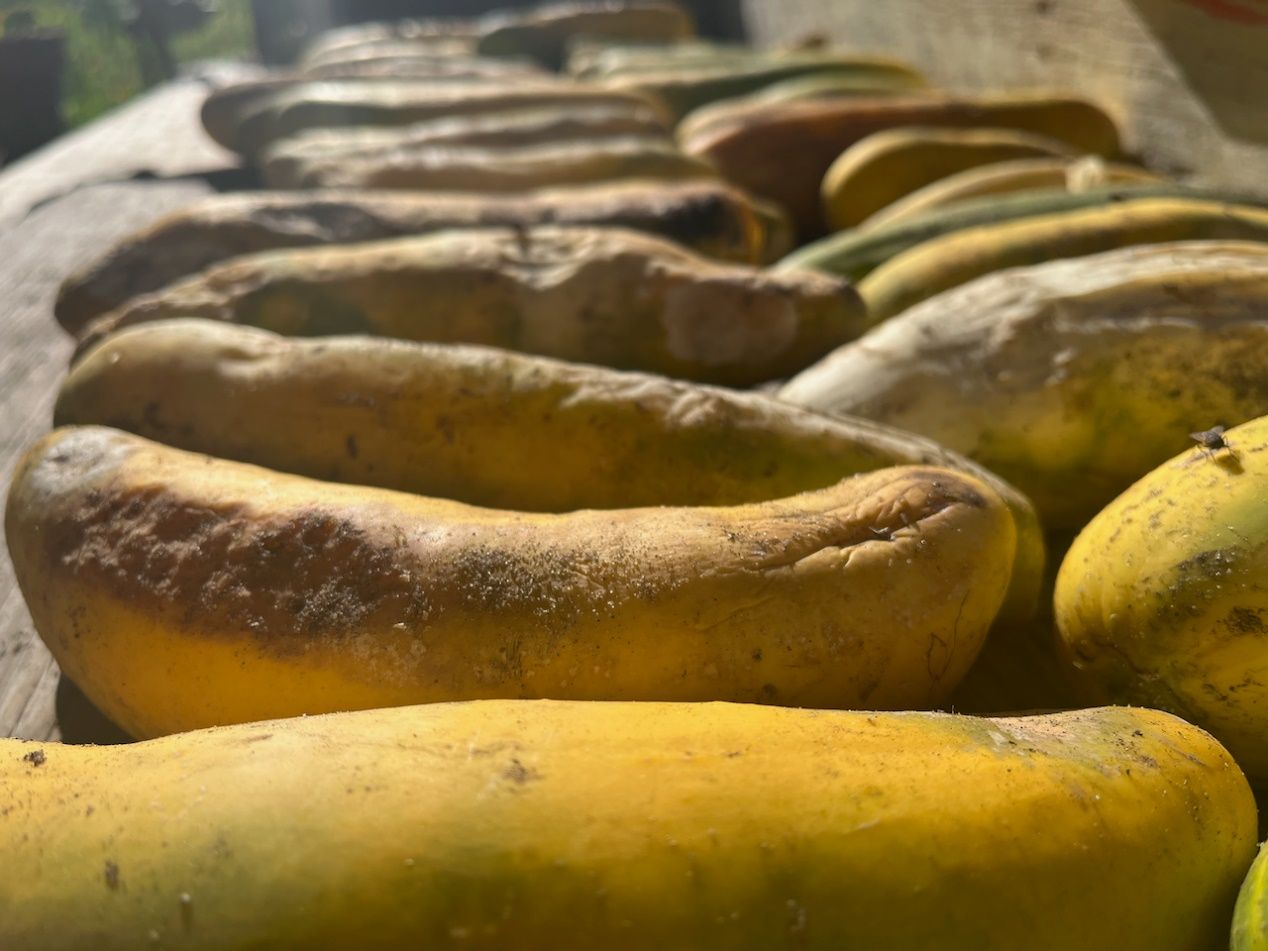
Credit: Melissa DeSa, Working Food
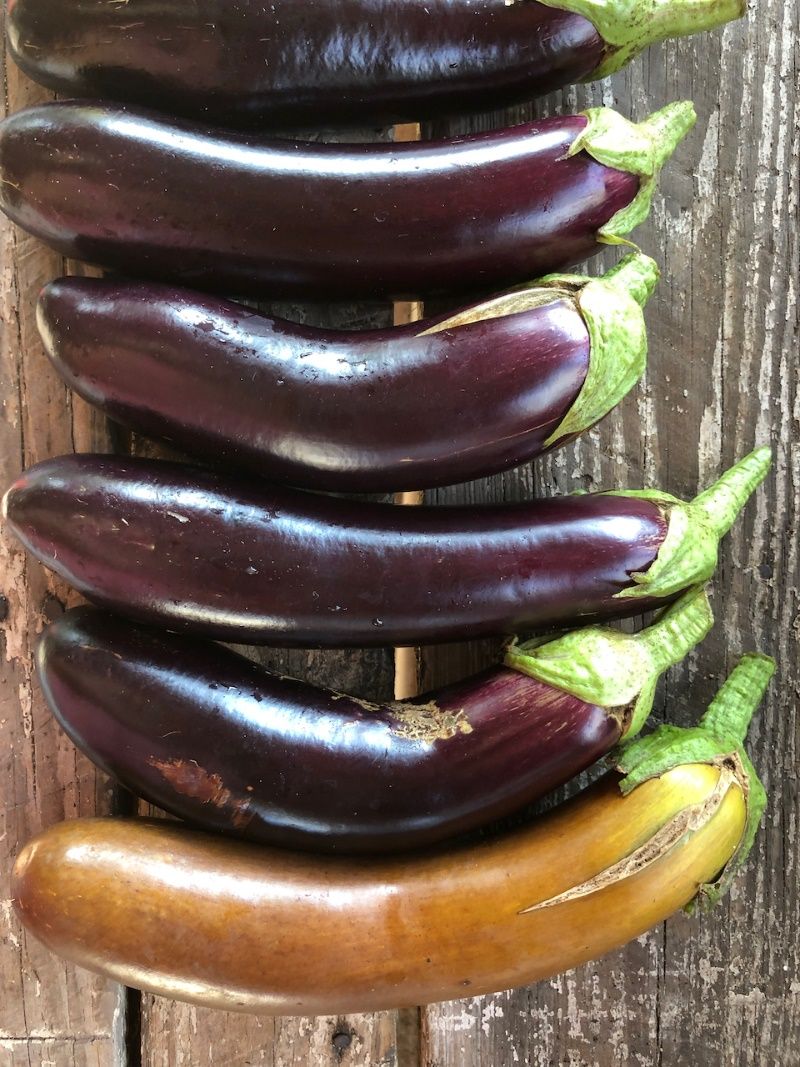
Credit: Melissa DeSa, Working Food
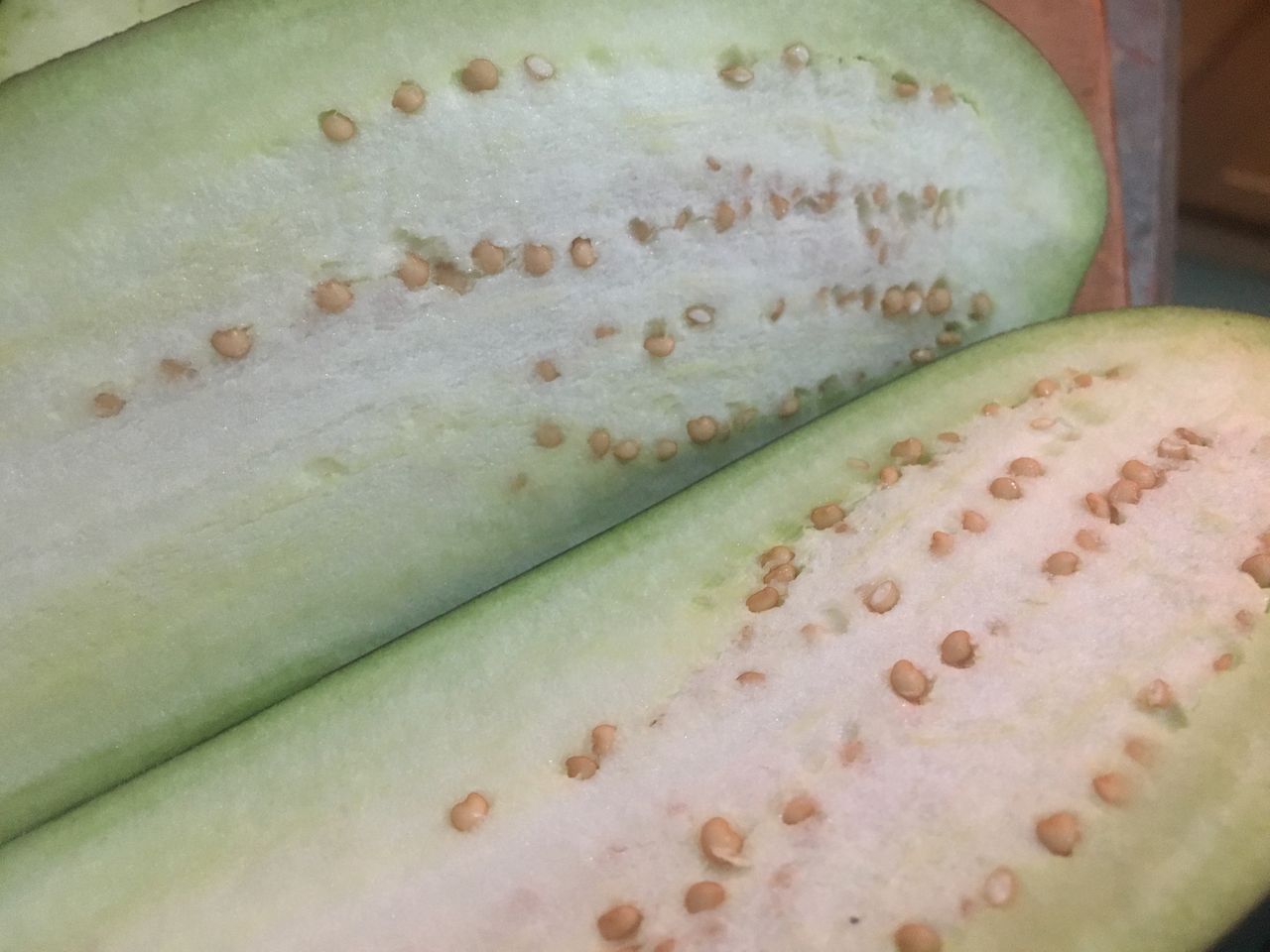
Credit: Melissa DeSa, Working Food
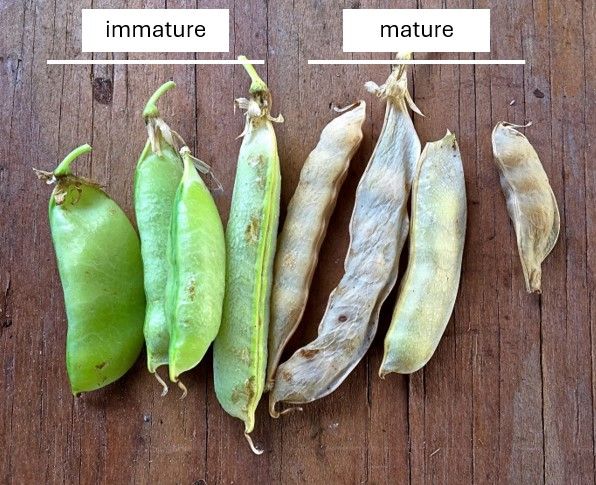
Credit: Wendy Free
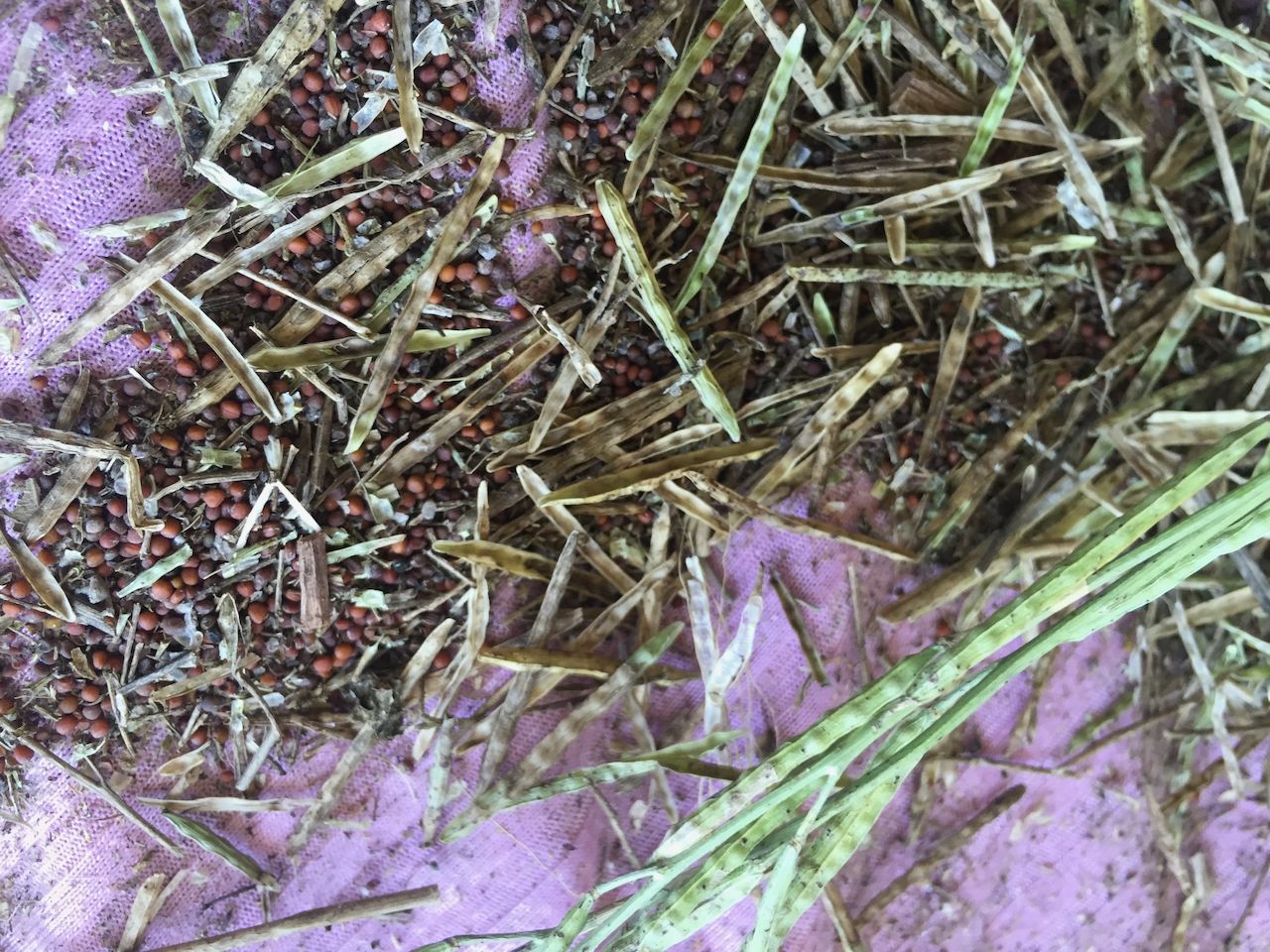
Credit: Melissa DeSa, Working Food
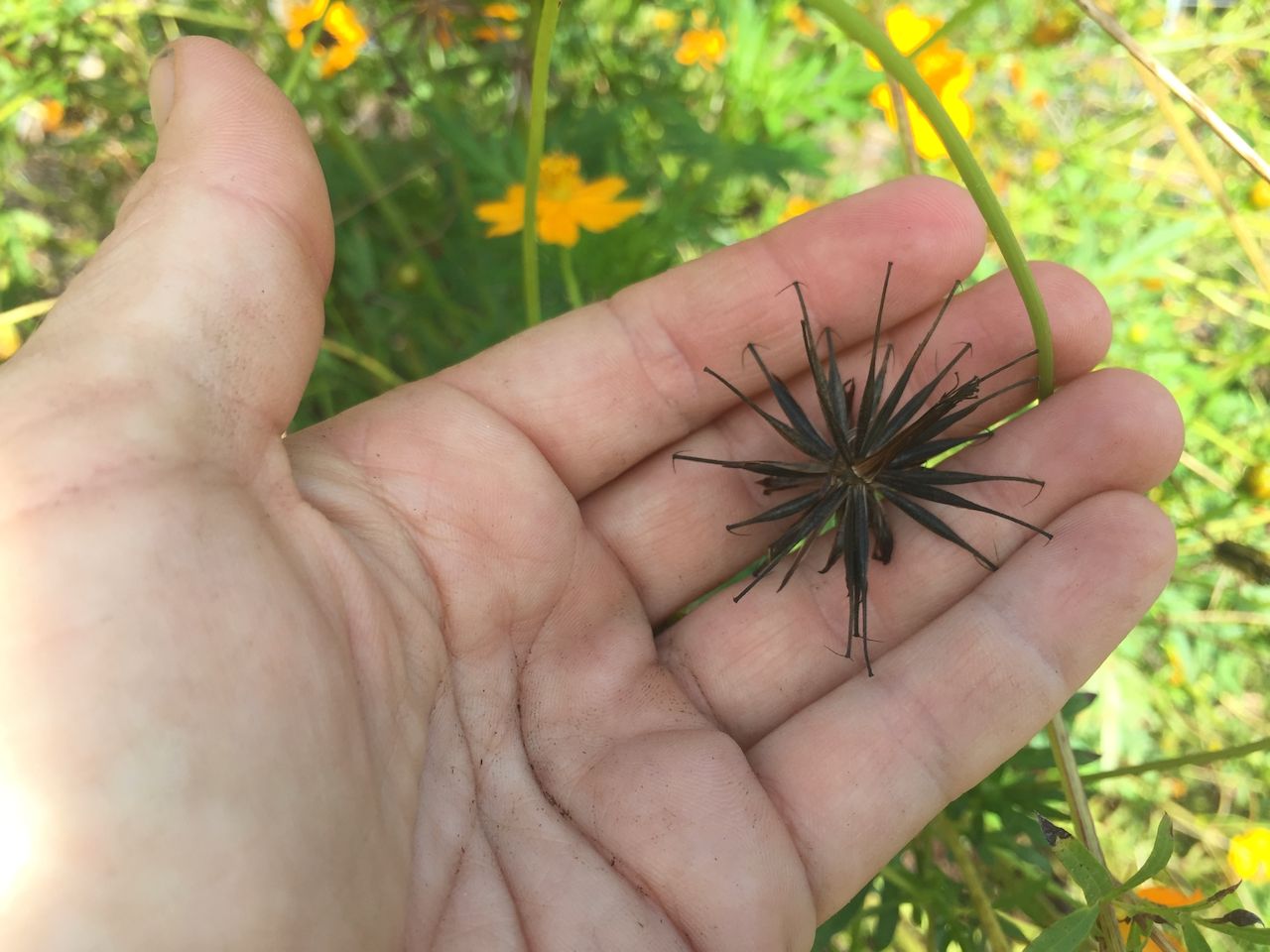
Credit: Melissa DeSa, Working Food
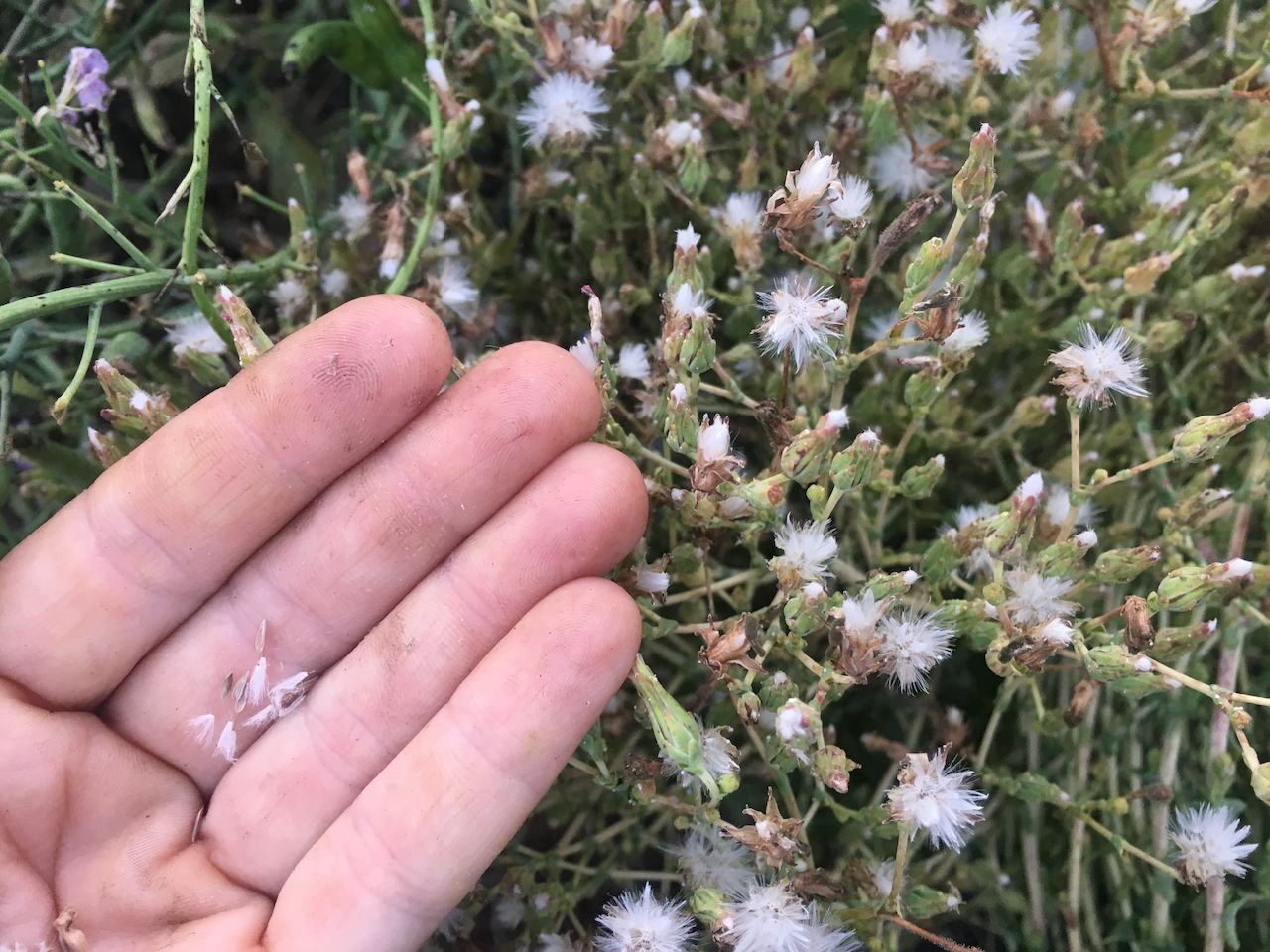
Credit: Melissa DeSa, Working Food
How do I select seeds to harvest?
Saving seeds should involve the selection of plants displaying favorable characteristics such as vigor, health, productivity, taste, and conformity with what the variety is supposed to look like. Pass on desirable traits, not bad ones, to the next generation: save from the best and eat the rest! It is important to keep good notes during cultivation, such as nutrient application needs, disease and pest issues, overall growth patterns, planting and harvesting dates, and use in the kitchen. These notes will be helpful to you later and when sharing seeds with others who do not have this information. Take many photos!
If you are sharing seeds with others, especially if you are planning to sell seeds, it is critical that you do not save seeds from plants suspected to have suffered disease. Note that some diseases can be transmitted by infected seeds. Several EDIS publications are useful sources of information. For instance, reports about sweet basil (https://edis.ifas.ufl.edu/publication/PP113) and lettuce (https://edis.ifas.ufl.edu/publication/HS1385) refer to seed-transmitted diseases and symptoms of the diseases. The UF/IFAS Plant Diagnostic Center will test plant and seed samples for a nominal fee. Testing is the most accurate way to determine what disease may be present. See the Plant Diagnostic Center website for instructions on how to submit a sample: https://plantpath.ifas.ufl.edu/extension/plant-diagnostic-center/.
How do I store seeds?
Under good conditions, the average garden seed can last for 2–10 years depending on the crop. There are four words to remember to achieve optimal seed storage conditions: dry, cool, stable, and dark. Dryness can be hard to achieve in the humid Southeast but try your best as it is the most important factor. For every 1% drop in moisture content, the storage life of a seed doubles (Harrington 1972). Each year, some seeds will lose viability, especially if storage conditions are poor. Dry seeds as much as possible before storage to prevent mold and insects.
According to Motis (2010), a home dehydrator may be effective, especially for drying larger seeds, but temperatures should be kept below 100°F (37.8°C) to prevent damaging seeds. A small room or closet with a dehumidifier running continuously may achieve ambient low humidity conditions for larger amounts of seeds. Also see Motis (2010) for designs of a drying cabinet.
Rao et al. (2006) provides a table that predicts a crop seed’s moisture content based on the ambient relative humidity. Seed moisture content approximations at different relative humidity are provided for several crops in Table 2. For the best possible storage conditions, seed moisture content should be between 5%–10%. This is not easily attainable in humid sub-tropical conditions, but this range gives those interested in storing seeds an idea of what to strive for.
Clay zeolite beads or silica beads can be used to dry seeds that have been removed from pods or fruits. Place a breathable mesh bag filled with beads into a sealed jar with the seeds. As the beads absorb moisture from the surrounding air, seeds will lose moisture. Once the seeds are dried, remove the beads, recharge them according to the manufacturer’s instructions, and store the seeds in a sealed container. Small seeds (e.g., brassica) may dry in about one week. It may take two weeks or more for larger seeds (e.g., bean, squash) to dry to target levels. An inexpensive hygrometer placed inside a clear jar with the seeds and beads is a good indicator of the moisture level. Getting below 35% relative humidity is ideal to prevent insect, bacterial, and fungal growth (Bradford et al. 2018).
A simple shatter or snap test for larger seeds is a good indicator of dryness. If you can snap a large pumpkin seed in half cleanly, it is dry. If it bends or resists, it is still too wet to store. If you can shatter a bean seed with a hammer on a hard floor, it is dry. If it smashes, it is still too wet for storage. Smaller seeds dry more quickly and sufficiently but cannot be snapped or smashed easily as a test.
Keep dried and cleaned seeds in labeled paper bags or envelopes inside a sealed, air-tight container like a glass jar or plastic container with a rubber-lined gasket lid. Find a cool, stable, and dark place to keep them. A closet or under the bed works well. A refrigerator or freezer works well too, but containers should be placed in the back where temperature and humidity are a little more stable. Never store seeds in warm places or expose them to continuous light.
Summary
There are many great reasons to save seeds, even though they are easily purchased in many places. Seed saving ensures that varieties important to you are preserved and shared. There is no guarantee all crop varieties will be maintained and offered by seed companies indefinitely, and indeed, many have been dropped and have become unavailable to growers. Saving seeds allows you to select and improve crop characteristics like flavor, vigor, nutritional quality, and regional adaptation. These are not always the same goals for seed companies and breeders, who may focus on commercially important traits. Preservation and improvement of locally adapted varieties are critical for improving food security and helping increase regional biodiversity. Saving seeds may also save money on future seed purchases. Sharing them with others helps grow community connections as we save, share, and tell the stories of the seeds and their cultivation with others. Understanding basic principles such as plant reproduction; how plants are pollinated; seed development; population size; isolation; and basic harvesting, processing, and storage techniques will help you become a better seed saver. With some careful consideration and observation, you can save seeds every season and incorporate them into any growing practice.
Basic Tools for Seed Saving
- Harvesting bags or bins
- Paper yard-waste bags for drying bulk amounts of crops and seeds and paper lunch bags for smaller amounts
- Scissors/knife/pruners
- Mesh bags with closures/ties for drying seeds or holding drying beads
- Screen/strainer/sieve/sifter to winnow chaff from seeds or to dry seeds on
- Paper envelopes for seed storage
- Mason jars or sealed containers with rubber gasket rings that are airtight
- Gloves and mask for plant material irritating to hands or lungs
- Box fan for winnowing away chaff
- Dehydrator or dehumidifier for drying seeds
- Drying beads (zeolite, silica) for drying seeds
- Hygrometer for determining the relative humidity
References
Bradford, K. J., P. Dahal, J. Van Asbrouck, K. Kunusoth, P. Bello, J. Thompson, and F. Wu. 2018. “The Dry Chain: Reducing Post-Harvest Losses and Improving Food Security in Humid Climates.” Trends in Food Science & Technology 71: 84–93. https://doi.org/10.1016/j.tifs.2017.11.002
Buttala, L., and S. Siegel, eds. 2015. The Seed Garden: The Art and Practice of Seed Saving. Seed Savers Exchange.
Harrington, J. F. 1972. “Seed Storage and Longevity.” In Seed Biology III: Insects, and Seed Collection, Storage, Testing, and Certification, edited by T. T. Kozlowski. Academic Press. https://doi.org/10.1016/B978-0-12-395605-7.50009-0
Motis, T. 2010. “Reducing Moisture Content of Seeds Prior to Storage.” ECHO Development Notes 109: 1–8. http://edn.link/edn109
Rao, N. K., J. Hanson, M. E. Dulloo, K. Ghosh, A. Nowell, and M. Larinde. 2006. “Manual of Seed Handling in Genebanks.” Handbooks for Genebanks 8. https://hdl.handle.net/10568/2945
Table 1. Crop-specific seed saving guidelines for north Florida. For population size, three numbers are offered: viable seeds (not ideal but will produce seeds), variety maintenance (better), and genetic preservation (best). Isolation distance refers to the minimum distance between groups of plants of the same species.
Table 2. Moisture content approximations of some common crop seeds at 77°F (25°C). Ideally, seed moisture content should be between 5%–10%, which can be challenging in humid climates. Drying methods should be deployed, and readings of ambient relative humidity (RH%) inside seed storage containers can be obtained easily with an inexpensive hygrometer to estimate seed moisture content. Seeds not listed may be estimated based on their closest related crop.